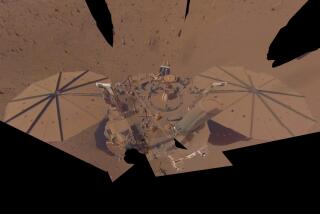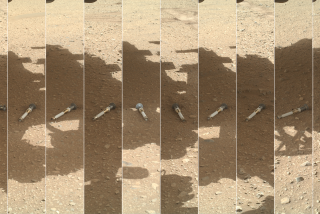Phoenix spacecraft lands on Mars
The first spacecraft designed to taste the water of an alien planet landed safely on Mars’ northern pole Sunday afternoon, beginning a three-month mission to determine whether the Red Planet ever did, or still might, support rudimentary forms of life.
The Phoenix spacecraft parachuted to the planet’s surface at 4:53 p.m. PDT, successfully ending a 296-day, 422-million-mile journey.
Cheers and applause echoed through the halls of NASA’s Jet Propulsion Laboratory in La Cañada Flintridge, which is managing the mission.
“Touchdown signal detected,” said Richard Kornfeld, a communications specialist. “Welcome to the northern plains of Mars.”
The landing of the 7-foot-tall, 904-pound craft, built by Lockheed Martin Space Systems Co., was an elegant feat of engineering and artistry.
“We have the best team in the world,” said an exultant Barry Goldstein, the project manager, who has devoted the last five years to this mission.
About two hours after the landing, the first images came back from Phoenix crystal clear, showing that its solar arrays had been successfully deployed and the craft was sitting on a stable and safe surface.
“These images are telling us we have a healthy configuration for the spacecraft,” said Dan McCleese, chief scientist for JPL. “This looks like a good place to start digging.
“We haven’t sunk into the surface very deep at all,” he added. That could indicate that Phoenix is sitting on a Martian version of permafrost.
The black-and-white pictures gave scientists a glimpse of a landscape different from anything they have seen on Mars before. They appeared to show small rocks, soil and evidence of fissures.
Phoenix’s touchdown is the first successful landing on Mars since NASA’s twin rovers arrived in 2004, and the first soft landing -- using a parachute and thrusters instead of protective air bags -- since the Viking missions 32 years ago.
Given the technical difficulty of the landing, and the fact that prior to Phoenix only five of 12 spacecraft had successfully landed on Mars, scientists and engineers were more anxious than usual.
Peter Smith of the University of Arizona, the mission’s lead scientist, compared the descent to the surface to a window washer falling from a high-rise.
The name Phoenix, referencing the mythical bird rising from its own ashes, was derived from the Mars Polar Lander, which was lost in 1999 as it descended toward the surface.
The entry-descent-landing period, when the lander separates from the spacecraft, enters the atmosphere and brakes from 12,000 mph to 5 mph, has been described as “seven minutes of terror.”
The landing, however, appeared to be almost picture perfect. Each event, from the deployment of the parachute to the firing of the thrusters that slowed the lander for the final 300 feet to the surface, occurred just as JPL had planned.
As Phoenix whisked through the Martin atmosphere, temperatures on its heat shield reached 2,600 degrees Fahrenheit.
After slowing in the thin atmosphere, the craft’s parachute opened, reducing its descent to 5 mph as it approached within 100 feet of the surface.
Fears that Phoenix might land on rocks failed to materialize. It came to a rest tilted just a quarter of one degree.
“It’s almost horizontal to the surface,” Smith said, smiling.
Phoenix’s landing site was chosen with safety in mind. Pictures taken from space showed a mostly featureless plain in the northern reaches of an area called Vastitas Borealis.
One small area contained a pile of rocks, and mission controllers had considered changing the spacecraft’s course to avoid it. In the end, they decided the chance of hitting it was so small, about 1 in 1,000, that there was no point in making the course correction.
Because radio signals take about 15 minutes to make the journey to Mars, there was no way for controllers to make corrections once the craft’s descent had begun.
The danger of the three-legged craft landing on a rock was that the lander might tip over or become so unstable that its robotic arm wouldn’t have the leverage to penetrate an ice layer just below the surface. That layer is expected to be as hard as cement.
With Phoenix settled in its new home, the hard work now begins for the $420-million mission. Over the next three months, the spacecraft will begin assessing its environment, including temperature, humidity and wind conditions.
Within a few days, it will deploy its 7.7-foot-long robotic arm, which will dig into the soil and the ice layer, possibly less than a foot beneath the surface. It will transfer small amounts of the soil to ovens, which will cook the samples to search for evidence of carbon-containing organic molecules that could provide a habitat for life.
“We think organics must exist at Mars, at least at one time,” Smith said. If nothing else, they would have been deposited by space rocks or cometary material during the 4-billion-year life of the planet, he said.
NASA’s planetary explorations in recent years have been guided by the motto “Follow the water,” Smith said.
This is because life as humans understand it needs water, both as nourishment and as a medium for organic processes to take hold.
A number of missions have found water on Mars, Saturn’s moon Enceladus and Jupiter’s moon Europa. But Phoenix is the first to travel to where the water is, to sample it and the soils around it for evidence of organic processes that could indicate a habitable zone.
Phoenix’s science instruments will look for molecules such as carbon and hydrogen, the basic building blocks of life on Earth.
These compounds can be produced without the presence of life, but their existence would encourage scientists who believe Mars could support some form of life. The two Viking spacecraft that landed on the Red Planet in 1976 made the only previous tests for organic chemicals in Martian soil. Both came up empty.
Those failures caused many scientists to abandon Mars as a potential home for living organisms until recent years, when NASA’s orbiting Mars Odyssey probe and other spacecraft found large quantities of water in the form of ice at both poles.
Phoenix will also check for other potential ingredients of life. It will examine the acidity of the soil at different layers and look for sulfates, which could be an energy source for microbes.
Scientists speculate that if some of the ice in the soil melts during warm periods, some form of microbial life could persist, potentially for millions of years.
Besides the robotic arm and mast camera, the lander’s instruments include a thermal and evolved-gas analyzer; a microscopy, electrochemistry and conductivity analyzer; and a meteorology station that will track weather patterns, particularly the winds that could carry humidity southward.
If the site proves to be promising, future missions could be designed to look directly for life, or fossils of it.
In 2010, the Mars Science Laboratory, a lander as large as an automobile and equipped with a ray-gun-like laser to zap rocks at a distance of 30 feet, is scheduled to follow up on Phoenix’s discoveries.
The ground beneath Phoenix will be different from the land forms explored by the twin Mars Exploration rovers, Spirit and Opportunity. For the last four years, the rugged rovers have been searching more equatorial regions of the planet, focusing on rock forms that show evidence of ancient standing pools of water.
The surface at the pole is expected to be more like a parched lake bed, with large polygonal shapes about 15 feet across, broken up by cracks. Such cracks could provide access to the ice below, Smith said.
Although carbon dioxide ice comes and goes with the Martian seasons, large stores of water ice remain underground all year long.
Scientists think this ice could be the remnant of a vast northern sea that existed when Mars had a thicker atmosphere. Potential evidence for this sea is the relative flatness of the terrain in the northern latitudes.
Some scientists think some of this ice might even melt and flow as water during warmer points in Martian climate cycles.






